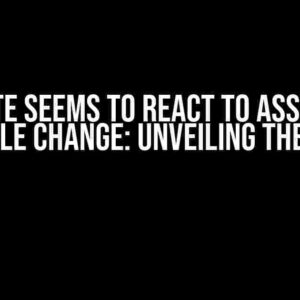As a web developer, there’s nothing more infuriating than running into a seemingly simple problem that becomes an insurmountable hurdle. One such issue that has left many developers scratching their heads is changing the currentTime of a video or audio tag. In this article, we’ll dive into the reasons behind this limitation, and most importantly, provide you with practical solutions to overcome it.
The Problem: Unchgangeable currentTime
Let’s set the scene: you’re building a media-rich application that requires precise control over video or audio playback. You’ve added the video or audio tag to your HTML, and now you want to programmatically change the currentTime to a specific moment. Sounds simple, right? Wrong! You try setting the currentTime property, but to your dismay, it doesn’t budge.
<video id="myVideo" width="640" height="480">
<source src="video.mp4" type="video/mp4">
</video>
<script>
let video = document.getElementById("myVideo");
video.currentTime = 10; // This should set the currentTime to 10 seconds, but it doesn't!
</script>You’ve tried everything: checking the video’s readiness state, using setTimeout, or even resorting to dark magic incantations (don’t pretend you haven’t tried that last one). But still, the currentTime remains stubbornly unchanged. So, what’s going on?
The Reason: Browser Security and Spec Compliance
Browsers have implemented strict security policies to prevent malicious scripts from messing with media playback. The HTML5 specification states that the currentTime property is only accessible when the media is in the “seekable” state, which means the browser has finished buffering the content and has a valid duration.
Furthermore, browsers also follow the W3C’s Media Source Extensions (MSE) specification, which dictates that the currentTime property can only be changed when the media is in a stable state, i.e., not during playback or seeking. This ensures that the browser can maintain a consistent and secure playback experience.
Solutions and Workarounds
Now that we understand the underlying reasons, let’s explore some creative solutions to overcome this limitation:
1. Use the media’s seekable property
One way to circumvent the currentTime limitation is to use the media’s seekable property, which returns a TimeRanges object. You can then use this object to determine if the desired seek position is within the seekable range.
<script>
let video = document.getElementById("myVideo");
let seekable = video.seekable;
let startTime = 10; // desired seek position in seconds
if (seekable.length > 0 && seekable.start(0) <= startTime && seekable.end(0) >= startTime) {
video.currentTime = startTime;
} else {
console.log("Sorry, the desired seek position is not within the seekable range.");
}
</script>2. Employ the media’s paused property
Another approach is to pause the video or audio, set the currentTime, and then resume playback. This works because the paused property allows you to temporarily halt playback, giving you a brief window to adjust the currentTime.
<script>
let video = document.getElementById("myVideo");
let startTime = 10; // desired seek position in seconds
video.pause();
video.currentTime = startTime;
video.play();
</script>3. Utilize the mediaSource and SourceBuffer
A more advanced solution involves using the MediaSource API and SourceBuffer to gain finer control over media playback. This approach requires creating a MediaSource object, adding a SourceBuffer, and segmenting the media into manageable chunks.
<script>
let video = document.getElementById("myVideo");
let mediaSource = new MediaSource();
let sourceBuffer = mediaSource.addSourceBuffer('video/mp4; codecs="avc1.64001f"');
let startTime = 10; // desired seek position in seconds
let chunkSize = 1000000; // adjust chunk size according to your needs
video.srcObject = mediaSource;
// fetch and process media chunks
fetch('video.mp4')
.then(response => response.arrayBuffer())
.then(arrayBuffer => {
sourceBuffer.appendBuffer(arrayBuffer);
// set the currentTime after appending the chunk
video.currentTime = startTime;
});
</script>Conclusion
While the inability to change the currentTime of a video or audio tag might seem like a frustrating limitation, it’s essential to understand the underlying security and spec compliance reasons behind it. By employing the solutions and workarounds presented in this article, you can regain control over media playback and create a more engaging user experience.
Remember, as developers, we must adapt to the ever-evolving landscape of web development and find creative ways to overcome the challenges that come our way. So, go ahead, take a deep breath, and tackle that pesky currentTime issue head-on!
Frequently Asked Questions
In this section, we’ll address some common questions related to changing the currentTime of a video or audio tag:
| Q | A |
|---|---|
| Why can’t I change the currentTime property directly? | The browser’s security policies and spec compliance prevent direct modification of the currentTime property to ensure a stable and secure playback experience. |
| Can I use JavaScript to change the currentTime? | Yes, but only when the media is in a stable state, and you use one of the workarounds mentioned in this article, such as using the seekable property, paused property, or MediaSource API. |
| Will this limitation be removed in future browser updates? | It’s unlikely, as the security and spec compliance reasons behind this limitation are fundamental to the web’s architecture. Instead, developers will continue to find creative ways to overcome this limitation. |
Additional Resources
For further reading and exploration, check out these resources:
- MDN Web Docs: HTMLMediaElement.currentTime
- W3C: Media Source Extensions (MSE)
- HTML5 Spec: HTMLMediaElement
By mastering the art of changing the currentTime of a video or audio tag, you’ll unlock new possibilities for interactive media experiences and take your web development skills to the next level.
Here are 5 Questions and Answers about “Can’t change the currentTime of a Video or Audio Tag” in HTML format:
Frequently Asked Question
We’ve got you covered! Check out these frequently asked questions about changing the currentTime of a Video or Audio Tag.
Why can’t I change the currentTime of a Video or Audio Tag?
The currentTime property of a Video or Audio Tag is read-only, meaning it can’t be directly modified. This is due to security restrictions in modern browsers, which prevent tampering with the media timeline to ensure a safe and secure media experience.
Is there a workaround to change the currentTime?
Yes, you can use the `seek()` method to move the playback position to a specific time. This method is supported in most modern browsers and is a safe way to modify the media timeline. For example, `video.seek(30)` would move the playback position to 30 seconds.
Can I use JavaScript to change the currentTime?
While you can’t directly modify the currentTime property, you can use JavaScript to call the `seek()` method or use other workarounds like creating a new media element and setting its `currentTime` property to the desired value. However, be aware that these workarounds might not work in all browsers or scenarios.
What are the consequences of trying to modify currentTime directly?
Attempting to modify the currentTime property directly can result in unexpected behavior, media corruption, or even security vulnerabilities. In some cases, it may even cause your media element to become unresponsive or crash. So, it’s best to stick with the recommended `seek()` method or other approved workarounds.
Are there any plans to change the currentTime behavior in the future?
The HTML5 specification is constantly evolving, and browser vendors are working to improve media handling. While there are no immediate plans to change the currentTime behavior, future revisions may introduce new APIs or modifications that could make it possible to modify currentTime directly. However, until then, it’s essential to follow best practices and use recommended workarounds.






